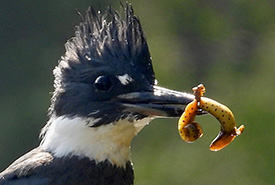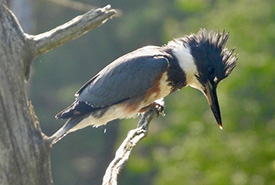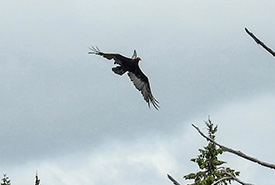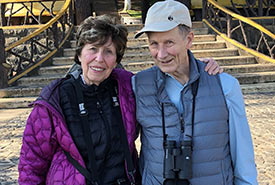NCC: Land Lines – Learning not to eat a newt

Beaver pond (Photo by Lenore Atwood)
Our encounters with the natural world are often unexpected and surprising. Lenore, an ardent nature photographer, looks over an ancient beaver pond while perching motionless on a log. “They also serve who only sit and wait” is her motto (borrowed from the poet Milton). Nothing noteworthy happens for a long time; then, suddenly, an event worth waiting for stimulates her photography reflexes.

The belted kingfisher holds the red-spotted newt, which it has just captured. (Photo by Lenore Atwood)
A young belted kingfisher became active and Lenore captured its hunting activity. The kingfisher (probably a young female, given the incomplete red chest band) dove into the pond and successfully captured newt (kingfishers usually don’t miss once they spot their prey). The kingfisher held the newt in its bill for several minutes (top picture). But then, Miss Kingfisher found the newt distasteful, did not attempt to ingest it, and dropped it in disgust (lower picture — kingfisher looking dejected). Why did she not eat it?
The best explanation is that many newts are poisonous, coating their skin with tetrodotoxin, one of the most powerful neurotoxins known. This is the same poison possessed by puffer-fish, which in Japan are considered a delicacy (fugu) but must be prepared by a cook with special training, since otherwise the dish could be lethal! The adult aquatic red-spotted newt has enough toxin to kill 250 mice, while the immature stage, the red eft, is 10 times more toxic; the western newts (rough-skinned newt and California newt) can be 100 times more toxic, and can kill a person who tries to eat one. However, local snakes have acquired immunity to tetrodotoxin through natural selection, so the California Newt is not completely protected from all predators.

The kingfisher has dropped the newt without trying to ingest it. (Photo by Lenore Atwood)
Did the kingfisher taste the poison, causing it to drop the newt? Our friend Milton Charlton (retired Professor Emeritus, Physiology, University of Toronto, with an interest in animal toxin warfare) thinks that the newt has several toxins and various repulsive secretions in the skin. The combined effect of the various skin secretions, including tetrodotoxin, would render the newt distasteful. Certainly, for us it would be!
Lenore observed that this kingfisher had a particularly bad day, for it later attracted the attention of a resident eastern kingbird. The kingbird attacked with vigour, feathers flew, and the kingfisher, unable to contend with its agile adversary, beat a hasty retreat!

Turkey vulture being attacked by kingbird. The kingbird’s wing appears over the vulture’s neck as it attacks from behind, jabbing the vulture with its beak. (Photo by Lenore Atwood)
Lenore also took a picture of a kingbird attack on a turkey vulture (many sizes larger than the kingbird) which flew down too close to the pond. The kingbird is unafraid of most other birds, however large they might be. (In the image, the vulture appears to have an extra wing coming from the back of its neck — this wing belongs to the kingbird, which is busily stabbing the vulture from behind with its beak!)





